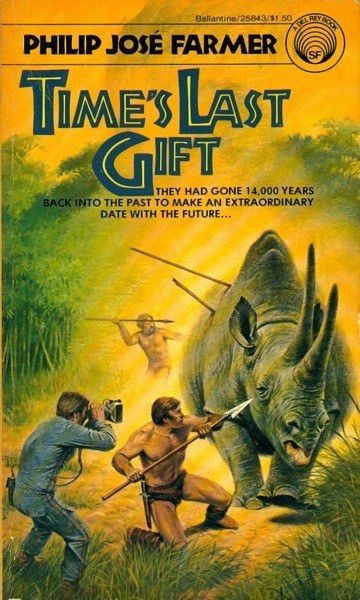Quick as a Cat
Time’s Last Gift
By Philip José Farmer

30 Jan, 2022
Because My Tears Are Delicious To You
0 comments
Philip José Farmer’s 1972 Time’s Last Gift is a time-travel novel. Revised in 1977, Time’s Last Gift shares continuity with Farmer’s Opar novels.
With a thunderclap, a time machine (H. G. Wells 1) appears in Stone-Age Europe. Geography having changed more than predicted between the 2070 from which the machine departed and the 12,000 BC when it arrived, the time machine immediately tumbles down a hillside. Thanks to prudent design, all of H. G. Wells’ occupants — beautiful Rachel Silverstein, disappointing Drummond Silverstein, German Robert von Billmann, and mysterious he-man adventurer John “not Tarzan” Gribardsun — are unharmed.
The explorers have four years in which to document Europe’s Stone-Age culture. Due to the way that time travel works (in this novel at least), nobody will ever be able to visit this era again. The scientists plan to make the best of those four years. Gribardsun has his own plans, which he does not care to share at this juncture.
Although the time travellers are heavily armed, it would be easy for one or more to die. Stone-Age Europe is home to species that have been extinct for millennia. Some, like the outsized hyenas, would be happy to eat any unwary human. Others, like the wooly rhino, would cheerfully trample humans to jam out of an excess of caution. It falls to Gribardsun, a white man raised in a reservation for savage Africans, to keep the others alive.
The party soon encounters stone-age Magdalenians, the Wota’shaimg tribe. They are clearly Europeans of a modern sort (homo sapiens). Their tech level is, as one would expect, primitive: stone tools. Basic hygiene is unknown; medical care is simple; life is hard and often very short. The Magdalenians aren’t stupid; they’re as smart as we are and have the skills that they need to survive in a challenging environment. But it’s not easy. Gribardsun does what he can to help out these primitive Europeans.
One of the Wota’shaimg, a certain Dubhab, is a ne’er-do-well of the sort that has always been with us. He always has an eye for the main chance, hoping to advance himself with the least effort possible. The strangers’ marvels, in particular their guns, occupy Dubhab’s mind. If he only had a gun …
Meanwhile, the Silverstein marriage is foundering. Rachel Silverstein is attracted to the brawny Gribardsun. Gribardsun resists her blandishments, but her husband, Drummond, is nonetheless angry at developments.
Thus, when someone begins trying to kill Gribardsun, it’s not at all clear who the culprit might be. Could be Dubhab. Could be Drummond. It could be both or someone else entirely. What is clear is that it’s very hard to kill a two-fisted adventurer like Gribardsun.
~oOo~
I may have misspoken earlier when I said Gribardsun was not Tarzan. If he is not Tarzan, then he is Tarzan’s non-union equivalent.
Farmer’s Tarzan-fanfic Opar novels are set 2000 years later than Time’s Last Gift, and in Africa rather than Europe. Readers need not worry about following the plot in this book if they’ve not read any of Farmer’s Opar books.
The book spends very little time in the 2070s, but enough time to make clear that so-called savages are now confined to reservations in Africa and elsewhere. The book was published in 1972 and revised in 1977 — but it gives the impression of having been written in a much older era. For his part, Gribardsun finds the reservations unsatisfactory only to the degree civilized values have displaced traditional ones. He’d rather take his chances with a lion than walk down Broadway.
On an unrelated note, modern readers would classify the time travellers as white, although I am not entirely certain Farmer did, given that he takes time to assure readers Rachel is attractive despite being dark and “long-nosed”.
It’s safe to say the anthropology in this has been superseded, if indeed it was ever consensus model. For example, the Stone-Age Europeans are described as white-skinned … but Cheddar Man (a human fossil from 10,000 BC) appears to have been dark skinned (as determined by DNA analysis). As well, during a foray south across a land bridge into North Africa, they find “no Negroes (…) nor had any of the Africans ever heard of black men.” Gribardsun mentions speculations that black Africans are originally from Asia. Any ideas where Farmer got that idea? In general, whenever this novel touches on paleoanthropology, I sense a subtext that I am better off not fully understanding. I wonder whether it all ties into Carleton S. Coon’s models, which pop up surprisingly frequently in old time SF1.
The plot itself is extremely linear and uncomplicated. The characters survive encounters with local wildlife and tribal warriors, while their allies often provide edifying examples of ways to die. Gribardsun is manly as all get out. Rachel adores him, Drummond resents him, and von Billman ponders Gribardsun’s odd accent.
There are one or two nice touches. For example, the novel dwells on the ephemerality of the archaeological record several times. A deceased young woman is buried; the tribe does its best to provide her with a lasting grave. The archaeologists are familiar with the site from their work in the future and know that all traces of the funerary rites will vanish in the next 12,000 years.
Otherwise… at least the novel is short enough that Farmer’s habit of sabotaging his narratives with needless complication does not come into play.
Time’s Last Gift is available here (Amazon US), here (Amazon Canada), here (Amazon UK), here (Barnes & Noble), here (Book Depository), and here (Chapters-Indigo).
1: Assuming that 2008 can be considered old time in certain circumstances. Ben Bova’s 2008 Mars Life is dedicated to Coon. Bova discusses why he did that here.
